What are DepEd’s MATATAG Curriculum Guides?
The MATATAG Curriculum introduced by the Department of Education (DepEd), is a redesigned educational framework intended to boost students’ achievement across critical subjects. This curriculum is a key part of DepEd’s efforts to tackle major educational issues, especially in foundational skills like literacy, numeracy and life skills with the goal of promoting well-rounded student development and better equipping them for future demands.
Core Aspects of the MATATAG Curriculum
This curriculum prioritizes focused content and essential competencies allowing for more meaningful and relevant instruction. By streamlining learning competencies, it enables teachers to explore important topics in greater depth rather than skimming through material. This approach supports students’ mastery of subjects, critical thinking and problem-solving abilities.
A central aspect of the MATATAG Curriculum is its focus on inclusivity and learner-centered strategies. The guides are structured to accommodate diverse learning needs, acknowledging the different paces and styles at which students learn. Additionally, it offers flexible learning options making education accessible to students of various backgrounds and circumstances.
Incorporating Lesson Exemplars and Assessment
The curriculum guides incorporate lesson exemplars offering teachers sample lessons that showcase effective teaching techniques and assessments in line with DepEd’s standards. These exemplars assist teachers in applying best practices, helping students achieve set learning goals. Moreover, assessments are seamlessly integrated into the curriculum to monitor students’ progress allowing for instruction to be tailored to their ongoing needs.
Goals of the MATATAG Curriculum Guides
The MATATAG Curriculum is designed to lay a solid foundation in academic and life skills, preparing students for lifelong learning. Through its emphasis on quality teaching and student-centered approaches, DepEd’s MATATAG Curriculum Guides aim to offer a more effective, inclusive and accessible education that meets global standards, equipping Filipino students for the demands of today’s world.
The current administration’s education plan is called MATATAG: Bansang Makabata, Batang Makabansa. It has four main goals:
- “Make the curriculum relevant to produce competent and job-ready, active, and responsible citizens;”
- “Take steps to accelerate delivery of basic education facilities and services;”
- “Take good care of learners by promoting learner well-being, inclusive education, and a positive learning environment; and”
- “Give support to teachers to teach better.”
The Department of Education also focuses on improving basic skills, embedding peace competencies, building resilient schools, strengthening inclusive education, advocating for more benefits for teachers and providing professional development programs.
The success of the MATATAG agenda relies on the support of various education stakeholders, who have committed to supporting this new education plan.
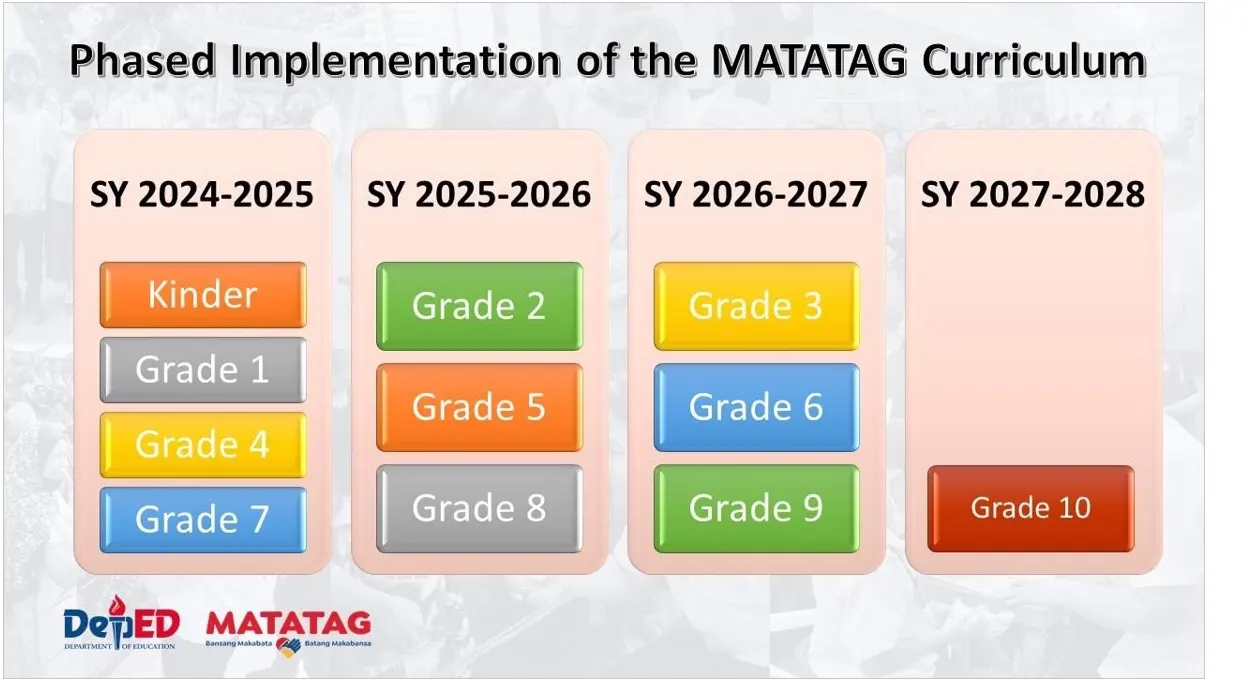
The following are the Matatag Curriculum Guides for each Grade level.
Kindergarten Matatag Curriculum Guide
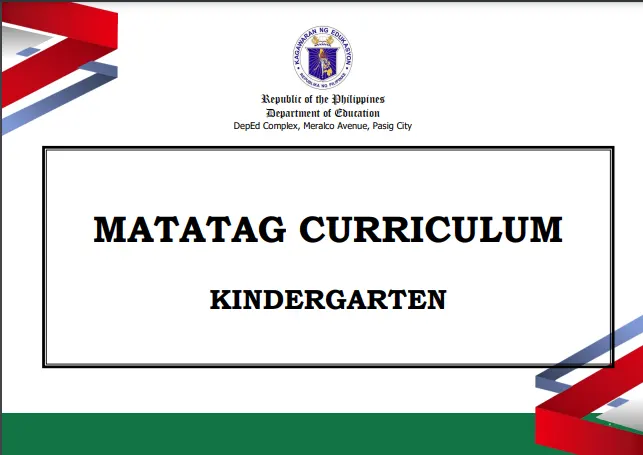
The Kindergarten curriculum aims to help young Filipino children grow and develop with modern skills. It focuses on building their sense of self, social and emotional skills, thinking ability, physical health, and positive attitudes. The curriculum is designed to develop skills needed for the 21st century by giving them fun, hands-on learning activities and offering activities suitable for their age. It encourages their thinking, creativity, communication, and problem-solving abilities, and promotes teamwork through group activities. Additionally, it provides learning experiences that are nationalistic and culturally relevant.
Download a Copy of Kindergarten Matatag Curriculum Guide Here
Grade 1 Matatag Curriculum Guide
Grade 1 – Matatag Language Curriculum Guide
The languages curriculum focuses on teaching students in their first language (L1) and adding other languages like Filipino and English. This helps them communicate well with others and understand the world better.
Learning different languages broadens students’ perspectives and gives them the chance to connect with others. It helps them understand, interpret, and create meaning in their relationships and cultural experiences. It also helps them think, express themselves, appreciate different views, and reflect on their experiences and role in society.
You can download the copy of Grade 1 Matatag – Language Curriculum Guide Here
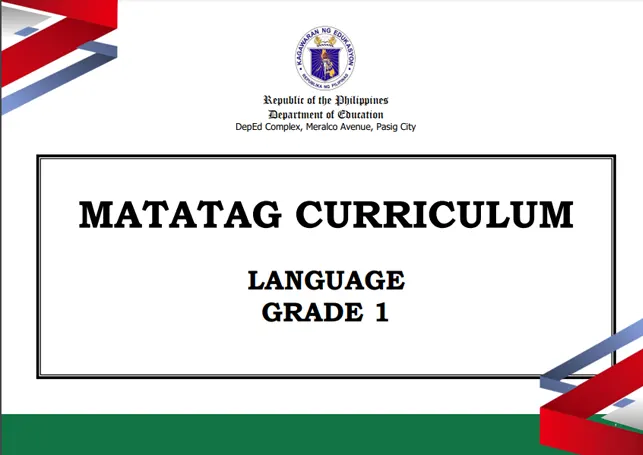
Grade 1 Matatag Makabansa Curriculum Guide
The primary aim of Makabansa is to develop students who understand themselves and their cultural awareness, have the skills to be healthy and creative, and have the ability to communicate with others and the community. The specific objectives of Makabansa are as follows: Strengthen students’ foundations in forming their identity as individuals and Filipinos; Enhance students’ abilities in movement, health, and creative expression of their emotions; and Strengthen the literacy foundations of students.
You can download the copy of Grade 1 Matatag Makabansa Curriculum Guide Here
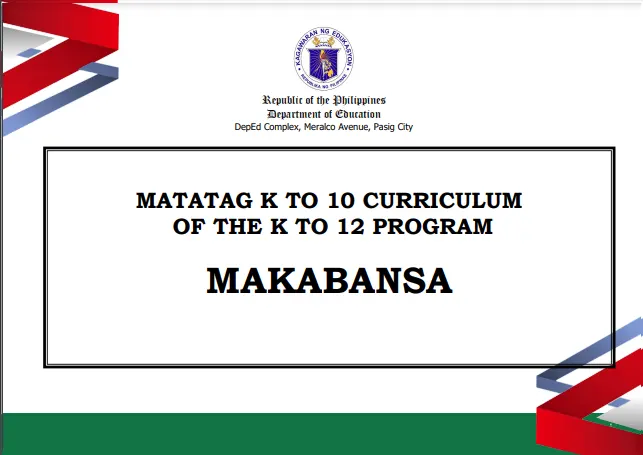
Grade 1 Matatag Reading and Literacy Curriculum Guide
The Reading and Literacy program aims to teach basic reading skills needed for early literacy, such as phonemic awareness, decoding skills, and recognizing sight words, in the student’s first language.
The new language curriculum reorganizes how languages are taught from Kindergarten to Grade 10. In Grade 1, students learn Language and Reading and Literacy. Starting in Grade 2, they learn Filipino and English simultaneously. The foundation built in the first language helps students transition to using Filipino and English for school and academic purposes. From Grade 2 onward, Filipino and English classes build on what students have learned in their first language and continue to develop their literacy skills in both languages and other subjects.
You can download the copy of Grade 1 Matatag Reading and Literacy Curriculum Guide Here
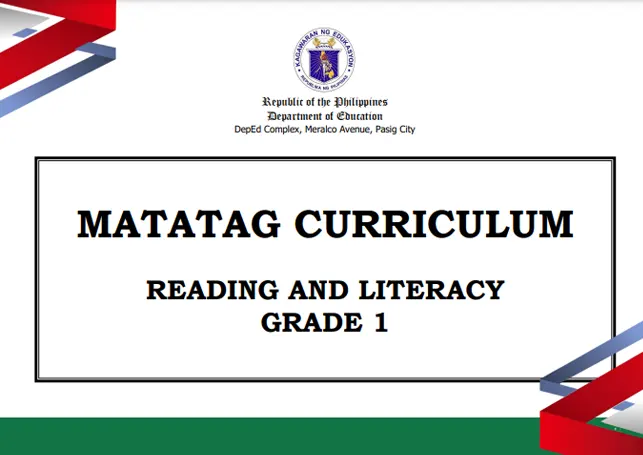
Grades 1 Matatag Mathematics Curriculum Guide
Key Stage 1 (KS 1) of the Mathematics curriculum focuses on Grades 1 to 3 learners. At this stage, the curriculum addresses the development of early numeracy by focusing on the learners’ understanding of 1-to-4-digit numbers, measures, basic shapes, and simple data. It also develops their fluency in carrying out procedures or operations involving these mathematical objects in their various representations (concrete, contextual, verbal, visual, and symbolic). Mastery of early numeracy concepts lays the groundwork for understanding more complex mathematical concepts and solving more complex problems. Learning experiences include basic mathematical explorations of these objects and operations that will engage learners in a variety of thinking processes in real, in situated, and in purely mathematical contexts. The goal of learning experiences is to support and strengthen the young learners’ interest and appreciation of mathematics as a tool for solving problems and for communicating ideas in everyday situations. The learning standards of the Key Stage 1 Mathematics curriculum aim to ensure that learners:
- ● accurately understand and apply concepts, operations, procedures, and relationships in solving routine and non-routine problems related to their day-to-day lives.
- acquire high-level skills and fluency in the procedures and processes of mathematics through varied frequent practice and meaningful learning experiences.
- communicate and represent mathematical concepts and understanding using developmentally appropriate language.
- acquire problem-solving and critical thinking skills through real, situated or purely mathematical problems.
- develop appreciation, curiosity, interest, creativity, and other desirable values, attitudes and dispositions in mathematics.
You can download the copy of Grades 1 Matatag Mathematics Curriculum Guide Here
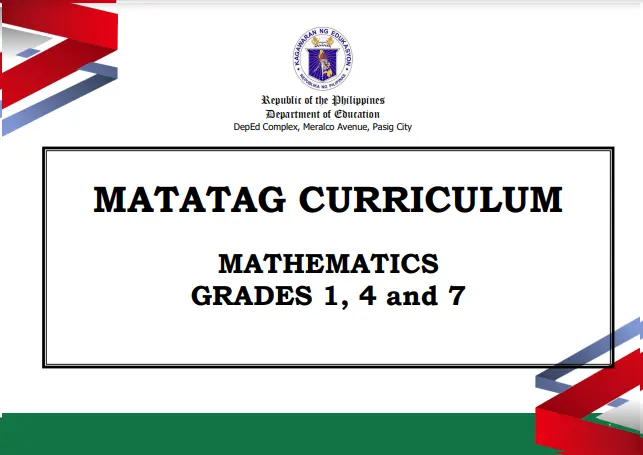
Grades 1 Matatag Good Manners and Right Conduct (GMRC) Curriculum Guide
Good Manners and Right Conduct (GMRC) o Kabutihang Asal at Wastong Pag-uugali refers to the specific and generally accepted basic social values, etiquette, and proper behavior that show respect for others. On the other hand, Values Education (VE) o Edukasyon sa Pagpapahalaga refers to the process of internalizing values in young people, aiming to teach students the ethical foundations of principles, the ability to act based on these principles, and the strengthened disposition to do so.
GMRC will be taught to students from Grades 1 to 6 as a primary subject and integrated into Kindergarten. Values Education will be taught to students from Grades 7 to 10 as a primary subject, with GMRC integrated into these grades. The time allotted for these subjects is similar to that of other primary subjects (Section 4, RA 11476).
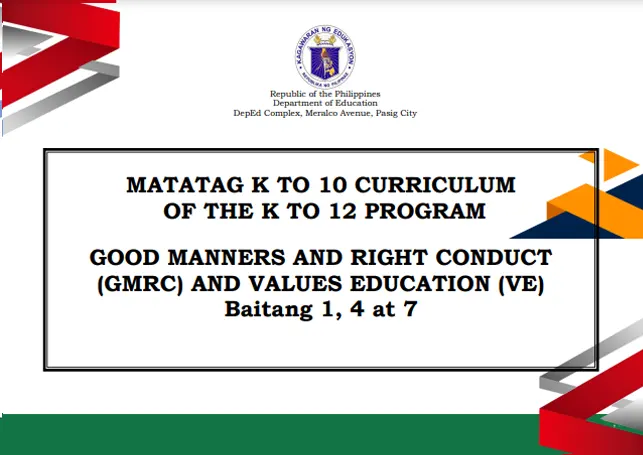
K to 12 Curriculum Guides
| Grade 2 Curriculum Guides |
| Grade 3 Curriculum Guides |
| Grade 5 Curriculum Guides |
| Grade 6 Curriculum Guides |
| Grade 8 Curriculum Guides |
| Grade 9 Curriculum Guides |
| Grade 10 Curriculum Guides |
Grade 4 Matatag Curriculum Guide

Grades 4 Matatag Mathematics Curriculum Guide
Key Stage 2 (KS 2) of the Mathematics curriculum focuses on Grades 4 to 6 learners. At this stage, the curriculum extends numbers, algebra, measures, geometry, data and probability. The coverage includes more complex properties, operations, and problems in different contexts that demand efficient written and mental methods of calculation. The learning standards of the KS 2 Mathematics curriculum aim to ensure that learners: ● use efficient mental and written mathematical concepts, operations, procedures, relationships, and tools to solve routine and non-routine real-world problems. ● reason and communicate using precise mathematical language to discuss ideas, investigate problems, and justify solutions. ● exhibit willingness and confidence to explore alternative solutions, and to take risks necessary to solve real-world problems. ● acquire problem-solving and critical thinking skills through real, situated, or purely mathematical problems; and ● enhance appreciation, curiosity, interest, creativity, and other desirable values, attitudes and dispositions in mathematics.
You can download the copy of Grades 4 Matatag Mathematics Curriculum Guide Here

Grades 4 Matatag Good Manners and Right Conduct (GMRC) Curriculum Guide
Good Manners and Right Conduct (GMRC) o Kabutihang Asal at Wastong Pag-uugali refers to the specific and generally accepted basic social values, etiquette, and proper behavior that show respect for others. On the other hand, Values Education (VE) o Edukasyon sa Pagpapahalaga refers to the process of internalizing values in young people, aiming to teach students the ethical foundations of principles, the ability to act based on these principles, and the strengthened disposition to do so.
GMRC will be taught to students from Grades 1 to 6 as a primary subject and integrated into Kindergarten. Values Education will be taught to students from Grades 7 to 10 as a primary subject, with GMRC integrated into these grades. The time allotted for these subjects is similar to that of other primary subjects (Section 4, RA 11476).
You can download the copy of Grades 4 Good Manners and Right Conduct (GMRC) Curriculum Guide Here
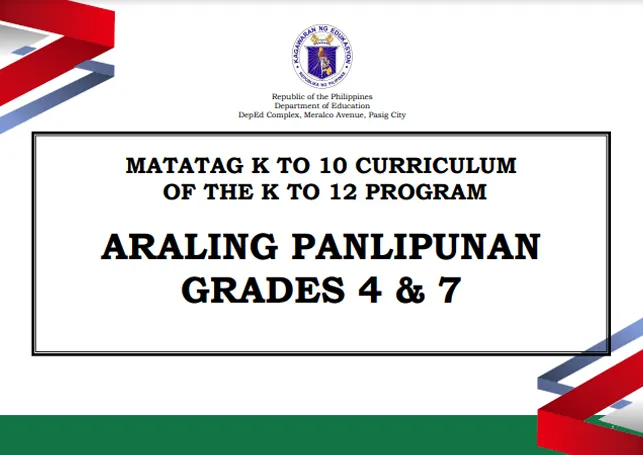
Grade 4 Matatag Araling Panlipunan Curriculum Guide
Araling Panlipunan focuses on the dynamic relationship between the individual and their society, including the global community and democratic institutions and structures that support and challenge their life. As an integrative, interdisciplinary, and multidisciplinary subject, it uses various perspectives and disciplines of Social Science, such as geography, history, sociology, political science, economics, and anthropology, to broaden and deepen the analysis of social issues and the role of the individual as part of the expanding society.
You can download the copy of Grade 4 Matatag Araling Panlipunan Curriculum Guide Here
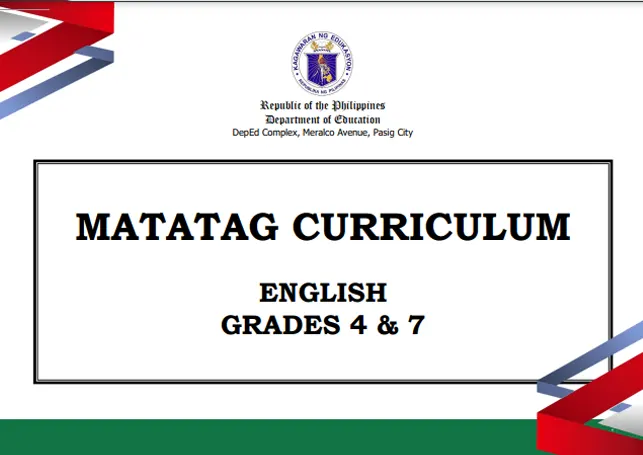
Grade 4 Matatag English Curriculum Guide
In Key Stage 2 (Grade 4 to Grade 6), the Filipino and English learning areas develop learners’ applied and critical literacy skills. Applied Literacy is the ability to think about particular ways of doing reading and writing with the purpose of achieving communicative goals in a socially appropriate manner. It is a useful tool for understanding literature, culture, and other disciplines. Critical Literacy is a critical thinking skill that involves the questioning and examination of ideas, and the skills to synthesize, analyze, interpret, evaluate, and respond to texts. It is the ability to evaluate the veracity of information and make connections and judgments of the relevance of information
You can download the copy of Grade 4 Matatag English Curriculum Guide Here
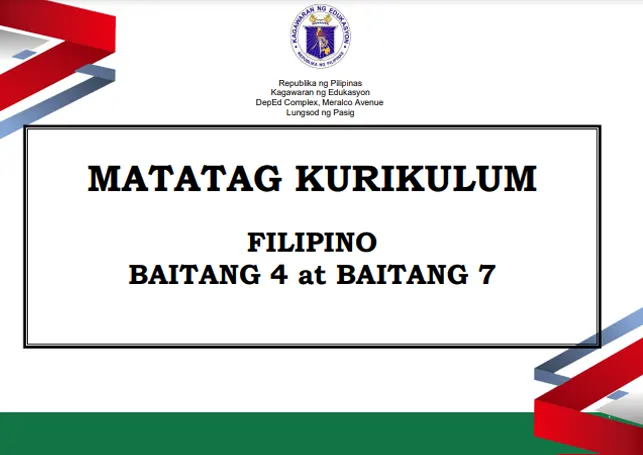
Grade 4 Matatag Filipino Curriculum Guide
Grade 4 students demonstrate basic and critical literacy skills, and develop macro skills in Filipino using discussions with various purposes, participants, contexts, situations, cultures, and themes. Additionally, they gain knowledge of visual elements to create different multimedia texts in Filipino, enhancing language skills with literacy attained in the first stage as evidence of learning progress. By the end of Grade 4, students are expected to demonstrate basic and critical literacy skills, and communicate using correct language (grammar) in discourse, paying attention to the appropriateness of knowledge, ideas, and emotions according to age, gender, culture, and purpose. Alongside this, they utilize acquired knowledge of visual elements in interpreting and analyzing issues concerning the community and the nation.
You can download the copy of Grade 4 Matatag Filipino Curriculum Guide Here
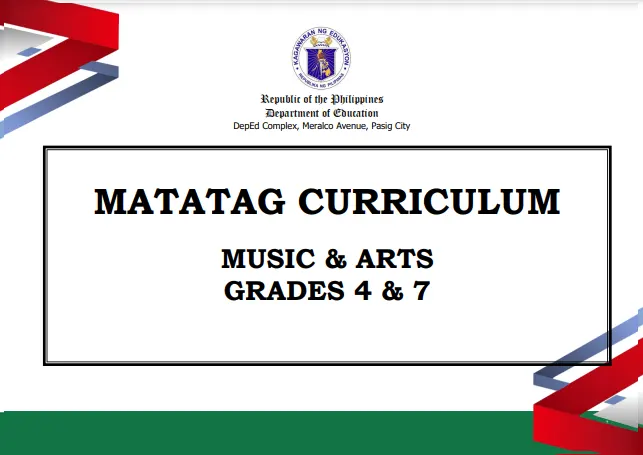
Grade 4 Matatag Music & Arts Curriculum Guide
Students demonstrate an understanding of how cultural identity and local traditions, including concepts, processes, and practices, influence creative decisions. They apply these local cultural and traditional concepts, processes, and practices in music and arts to create works reflecting their cultural identity.
Students show an understanding of local music and arts concepts, processes, and practices influenced by the faiths and beliefs of their province. They improvise creative works that depict these faiths and beliefs using local music and arts concepts, processes, and practices.
Students understand their cultural identity through local music and arts concepts, processes, and practices, and relevant narratives from their province. They create works based on these local narratives using music and arts concepts, processes, and practices.
Students demonstrate an understanding of their culture, province, and region through local music and arts concepts, processes, and practices. They produce creative works based on the performing and visual arts of their province.
You can download the copy of Grade 4 Matatag Music & Arts Curriculum Guide Here
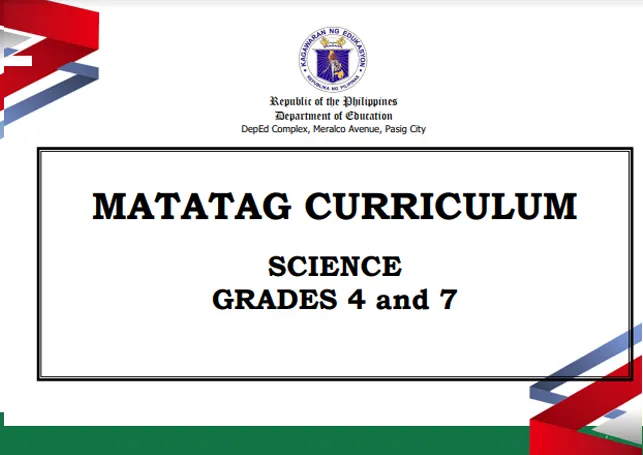
Grade 4 Matatag Science Curriculum Guide
At the end of Grade 4, learners describe chemical properties of materials and that changes to them are sometimes harmful. They identify that plants and animals have systems whose function is to keep them alive. They observe, describe, and create representations to show how living things interact with their habitat, survive, and reproduce. They use diagrams to show the feeding relationship among different organisms. Learners use simple equipment to identify types of soil that hold water and support plant growth. Learners use simple equipment and processes to measure and record data about movement, and describe and predict how things around them move. They describe the concepts of speed and force. They recognize that science processes are used to gain deeper understanding about the properties of magnets, light, sound, and heat. Learners apply their developing observation skills and objectivity to identify where energy is evident in their local communities and how it is used by people. They use instruments and secondary sources to measure and describe the characteristics of weather and use the information to make predictions. Learners demonstrate appreciation for the dangers of extreme weather events and use safe practice to protect themselves. Learners use personal observations and reliable secondary information sources to describe the sun and explain its importance to life on Earth. They exhibit objectivity and open-mindedness in gathering information related to environmental issues and concerns in the community.
You can download the copy of Grade 4 Matatag Science Curriculum Guide Here:
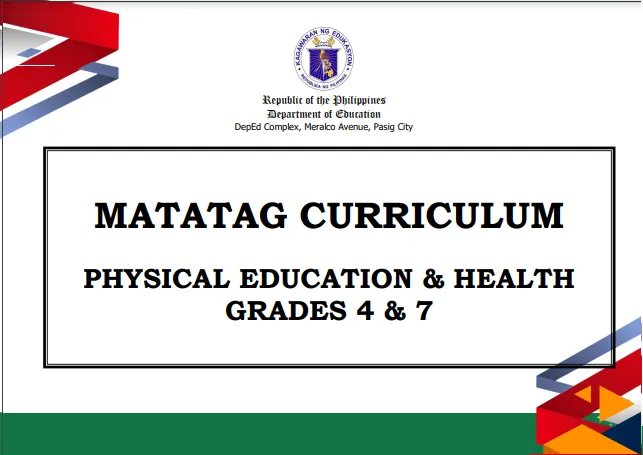
Grade 4 Matatag Physical Education & Health Curriculum Guide
Students demonstrate fundamental health practices, movements, and fitness skills to promote personal, family, community, and societal wellness for active and healthy living. They understand hygiene practices, basic health appraisals, and target games to enhance personal wellness, and actively participate in these activities. They grasp the concepts of healthy family dynamics, the roles and responsibilities of family members, and invasion games to support family wellness, and engage in related daily life activities. Furthermore, students comprehend the importance of healthy eating and rhythmic activities and dances for community wellness, and actively take part in these activities. They also understand basic health rights, consumer rights and responsibilities, health facts, fitness fads, and participate in rhythmic activities and dances to promote societal wellness for active and healthy living.
You can download the copy of Grade 4 Matatag Physical Education & Health Curriculum Guide Here
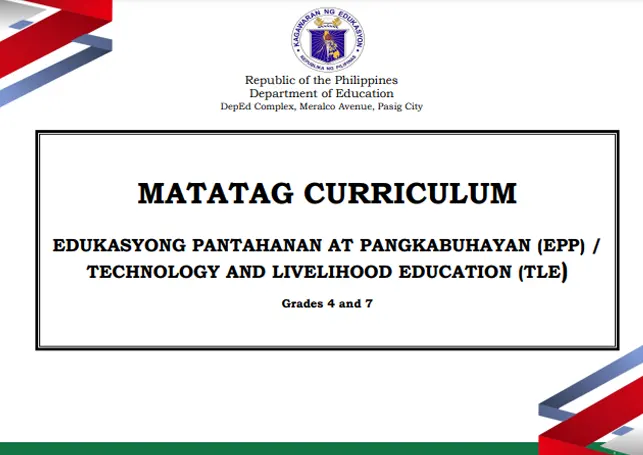
Grade 4 Matatag Edukasyong Pantahanan at Pangkabuhayan (EPP)/ Technology and Livelihood Education (TLE) Curriculum Guide
EPP/TLE is a learning area that provides learners with basic home skills that will enable them to be productive in life. The learners in Grades 4 to 6 will explore the fundamental home skills of the four components of EPP/TLE (Information and Communications Technology [ICT], Agriculture and Fishery Arts [AFA], Family and Consumer Science [FCS], and Industrial Arts [IA]).
Students demonstrate an understanding of the basic knowledge, skills, values, and attitudes in Information and Communications Technology (performing basic computer operations and using productivity tools), Agriculture (caring for ornamental plants, vegetables, and fruit-bearing trees), Family and Consumer Science (maintaining household order), and Industrial Arts (recycling used and/or leftover materials). This enables them to improve their personal, family, and community economic conditions.
Grade 7 Matatag Curriculum Guide
Grade 7 Matatag Mathematics Curriculum Guide
Key Stage 3 (KS 3) of the Mathematics curriculum focuses on Grades 7 to 10, covering algebra, measurement, geometry, and data and probability, with an emphasis on cognitive development for self-directed learning. At this stage, students delve into sets and real numbers, functions, equations, inequalities, sequences, axiomatic geometry, triangle congruence and similarity, basic trigonometry, statistical measures, and probability. The curriculum aims to ensure learners apply mathematical concepts and tools to describe, explain, investigate, model, and predict phenomena; reason mathematically and evaluate arguments; communicate mathematical information; utilize mathematical thinking in decision-making; and develop problem-solving and critical thinking skills. Learners will demonstrate knowledge and skills in Number and Algebra (percentages, rates, rational and irrational numbers, sets, integers, operations, scientific notation), Measurement and Geometry (polygons, angles, units, volumes), and Data and Probability (data collection, presentation, interpretation). This knowledge is applied, using technology, to critical thinking, problem-solving, communicating, reasoning, and making connections within mathematics.
You can download the copy of Grade 7 Matatag Mathematics Curriculum Guide Here

Grade 7 Matatag Values Education (VE) Curriculum Guide
Values Education (VE) refers to the process of internalizing values in young people aimed at teaching students the ethical foundations of principles, including the ability to act based on these principles, and developing a firm disposition to do so. The students demonstrate understanding of concepts and actions related to values based on Ethics, showing love for oneself, family, others, God, nature, country, and the world towards the common good. They also demonstrate understanding of concepts and actions related to values that help fulfill their responsibilities, showing love for oneself, family, others, God, nature, country, and the world.
You can download the copy of Grade 7 Matatag Values Education (VE) Curriculum Guide Here

Grade 7 Matatag Araling Panlipunan Curriculum Guide
Araling Panlipunan focuses on the dynamic relationship between the individual and their society, including the global community and democratic institutions and structures that support and challenge their life. As an integrative, interdisciplinary, and multidisciplinary subject, it uses various perspectives and disciplines of Social Science, such as geography, history, sociology, political science, economics, and anthropology, to broaden and deepen the analysis of social issues and the role of the individual as part of the expanding society.
You can download the copy of Grade 7 Matatag Araling Panlipunan Curriculum Guide Here

Grade 7 Matatag English Curriculum Guide
The Filipino and English learning areas play a crucial role in developing learners’ multiliteracies, enabling them to understand and communicate across diverse contexts using written, visual, audio, gestural, tactile, and spatial modes of expression. In Key Stage 3 (KS3), the focus is on applying literacy skills—basic, critical, and applied—and language knowledge (communicative competence in Filipino and English) to critically assess, create, and publish a variety of texts, including spoken, written, and multimodal formats. These activities are centered around developmentally and grade-level appropriate themes, with a focus on informational texts (70%) and narrative texts (30%). By the end of Grade 10, students can analyze and evaluate literary styles, forms, and features across various text types—literary, informational (non-journalistic, journalistic, academic), and transactional. They are capable of composing and publishing multimedia texts for diverse purposes and audiences, reflecting pride in their cultural heritage and evaluating visual elements for cultural relevance.
You can download the copy of Grade 7 Matatag English Curriculum Guide Here

Grade 7 Matatag Filipino Curriculum Guide
students demonstrate communicative skills, creativity, and critical understanding of written texts, Masterpieces, and visual texts using Filipino as an intellectual language reflecting multilingual and multicultural literacy towards creating and presenting multimodal texts. This aims to cultivate skills in understanding and analyzing texts with literacy acquired in the first stage and language skills from the second stage to become assets as national and global citizens. After Grade 7, students exhibit communicative skills and comprehend and analyze the Masterpiece Ibong Adarna, written texts like literature from the Indigenous Period to the Spanish Colonial Era, as well as informational, academic, and visual texts to create meaningful multimodal texts using learned linguistic elements towards shaping Filipino identity and values.
You can download the copy of Grade 7 Matatag Filipino Curriculum Guide Here

Grade 7 Matatag Music & Arts Curriculum Guide
he students create innovative artistic expressions that explore global communities through the lens of Filipino cultural identity and diversity. They employ both established and evolving concepts, processes, techniques, and practices in music and arts. Their creative output is guided by the customs and traditions of the Philippines and selected Southeast Asian countries, emphasizing Filipino cultural identity and diversity.
You can download the copy of Grade 7 Matatag Music & Arts Curriculum Guide Here

Grade 7 Matatag Science Curriculum Guide
By the end of Grade 7, learners apply models to explain the Particle Theory of Matter, utilizing diagrams to illustrate particle motion and arrangement during state changes. They analyze the roles of solutes, solvents, and factors influencing solubility in solutions. Demonstrating proficiency in scientific inquiry, they plan and conduct investigations with precision and standard units of measurement. Learners describe the function and components of a compound microscope, identifying cell structures and recognizing cells as fundamental units of life, distinguishing between unicellular and multicellular organisms. They differentiate between types of cell division and modes of reproduction. Using diagrams, they establish connections between organisms and their environments across various organizational levels, elucidating energy transfer in food chains. Employing systemic analysis, learners explore natural phenomena such as fault dynamics and earthquakes, assessing local earthquake risks using reliable data. They apply disaster management plans to educate others on earthquake and tsunami preparedness, explaining secondary impacts on coastal communities from tsunamis originating locally or distantly. Learners investigate how solar energy influences Earth’s atmosphere and weather systems, shaping national climate patterns. Utilizing scientific techniques, concepts, and models, they explore forces, motion, and energy through scientific language, force diagrams, and distance-time graphs. They propose solutions to motion and energy-related challenges, applying their knowledge to describe heat energy properties and exploring technological innovations for addressing global energy issues.
You can download the copy of Grade 7 Matatag Science Curriculum Guide Here

Grade 7 Matatag Physical Education & Health Curriculum Guide
Students demonstrate fundamental health practices, movements, and fitness skills to promote personal, family, community, and societal wellness for active and healthy living. They understand hygiene practices, basic health appraisals, and target games to enhance personal wellness, and actively participate in these activities. They grasp the concepts of healthy family dynamics, the roles and responsibilities of family members, and invasion games to support family wellness, and engage in related daily life activities. Furthermore, students comprehend the importance of healthy eating and rhythmic activities and dances for community wellness, and actively take part in these activities. They also understand basic health rights, consumer rights and responsibilities, health facts, fitness fads, and participate in rhythmic activities and dances to promote societal wellness for active and healthy living.
The learners incorporate health and physical literacy to advocate for active and healthy lifestyles across personal, family, community, and societal contexts. They utilize practical health practices along with principles from games and dance to enhance well-being at these levels.
You can download the copy of Grade 7 Matatag Physical Education & Health Curriculum Guide Here

Grade 7 Matatag Edukasyong Pantahanan at Pangkabuhayan (EPP)/ Technology and Livelihood Education (TLE) Curriculum Guide
EPP/TLE is a learning area that provides learners with basic home skills that will enable them to be productive in life. The learners in Grades 4 to 6 will explore the fundamental home skills of the four components of EPP/TLE (Information and Communications Technology [ICT], Agriculture and Fishery Arts [AFA], Family and Consumer Science [FCS], and Industrial Arts [IA]).
The learner demonstrates knowledge and skills of the basic and common competencies in the TLE Exploratory in the components of Information and Communications Technology, Agriculture and Fishery Arts, Family and Consumer Science, and Industrial Arts intensified integration of entrepreneurship.
You can download the copy of Grade 7 Matatag Physical Education & Health Curriculum Guide Here

